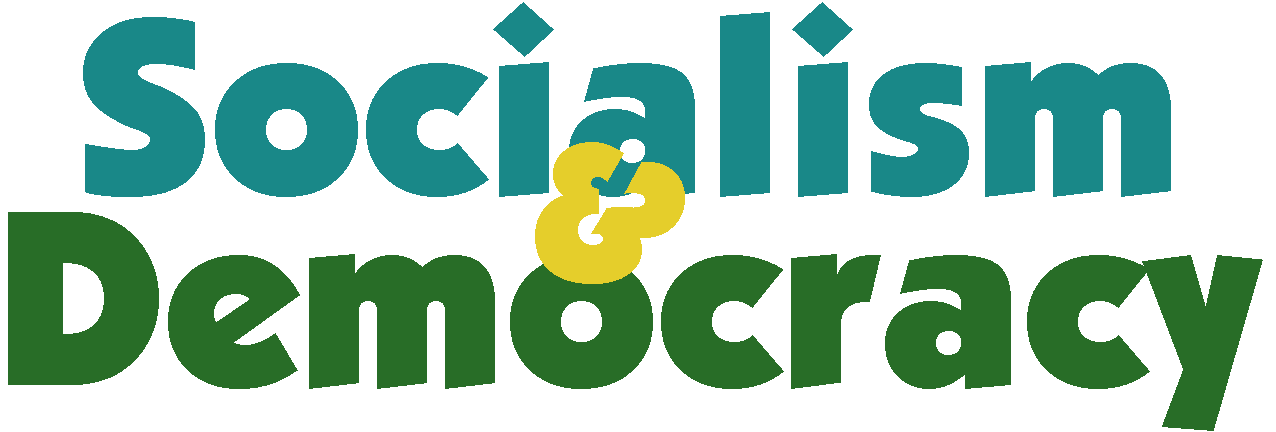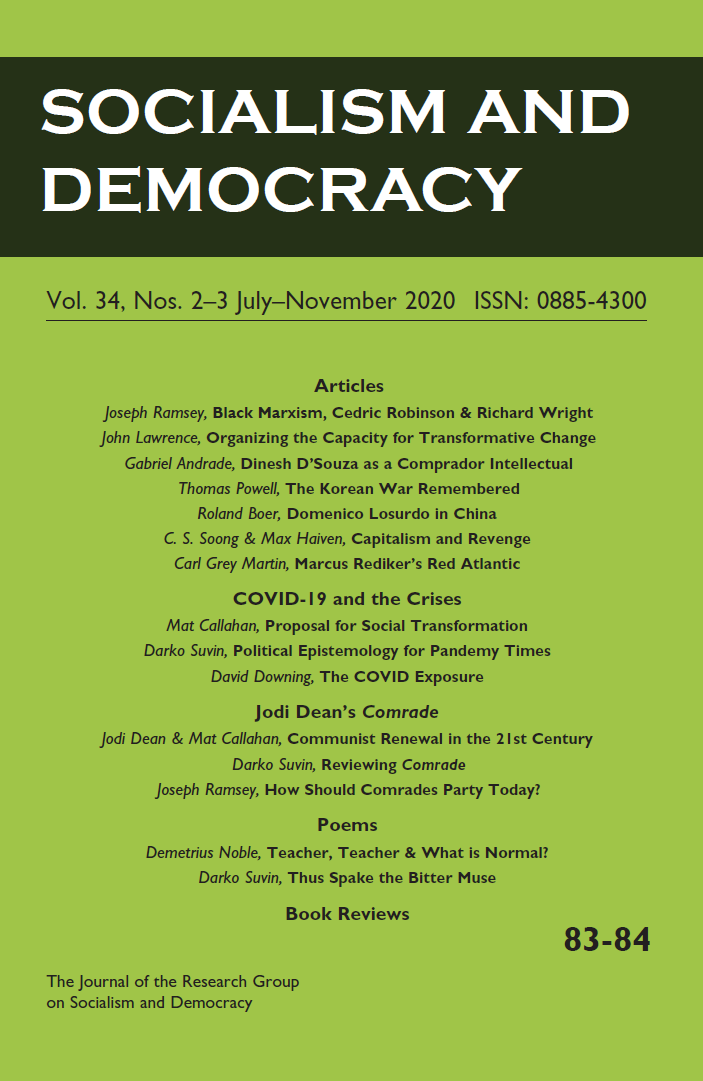Barbara Tomlinson and George Lipsitz, Insubordinate Spaces: Improvisation and Accompaniment for Social Justice. (Philadelphia: Temple University Press 2019), 271 pages, $27.
There is a growing effort among scholars to overcome Euro- and USA-centric theoretical outlooks, by engaging with epistemologies of the South. Tomlinson’s and Lipsitz’s book is an excellent illustration of such scholarship. The authors use the epistemologies of the South to analyze how acts of resistance turn everyday spaces into insubordinate spaces within the United States. They argue that education, the arts, and activism are terrains of political and ideological conflict. What may appear to be isolated actions are important contributions to what Wallerstein calls “middle-run” gains, partial, positive changes in the long-run struggle for social justice. According to Tomlinson and Lipsitz, each act does not, in itself, bring about the downfall of neoliberal ideology and capitalism yet each one is a step forward in the creation of the world we desire.
In addition to utilizing Wallerstein’s concept of the middle run (36-7), Tomlinson and Lipsitz lean on four key concepts in their social movement analysis: improvisation, accompaniment, konesans, and balans. The concept of improvisation is similar to the idea of innovation in social movement theory. A movement’s ability to improvise new forms of protests, new tactics and strategies, are important for its success. Improvisation similarly provides new venues to challenge oppressive structures and create the desired social relations. With the other three concepts, the authors introduce visions put forth in scholarship from the South. Accompaniment is reciprocal recognition, the acknowledgement of shared experience, solidarity, and mutual support. From Haitian Creole, konesans and balans connote more than knowledge and balance. Konesans moves beyond skills, facts and theories to acknowledge discernment, empathy, judgement, and respect for our ancestors’ experiences and ways of thinking. Balans is more than balancing opposing forces; it means to acknowledge and embrace the coexistence of contradictions and to move away from an either/or worldview into a “both/and” perspective. These four concepts and practices (improvisation, accompaniment, konesans, and balans) not only constitute what Tomlinson and Lipsitz refer to as a toolkit created by social justice activists; they also serve as the authors’ analytical tools to study the creation of insubordinate spaces. They analyze three instances where spaces are turned into insubordinate spaces.
In case of the Canadian Indigenous people’s movement, Idle No More, Tomlinson and Lipsitz highlight several examples of accompaniment. This movement brought together people from different backgrounds to fight for Indigenous sovereignty, social and environmental justice. While their worldviews varied, their solidarity led to new awareness, Konesans, regarding racism, policy toward Indigenous peoples, and the racializing of immigrants. Two other examples are the International Day of Action of 2013 that gathered 265 rallies globally, and the actions addressing the concerns of Indigenous women and youth. For Tomlinson and Lipsitz, these acts of solidarity, mutuality, and equality are the lived experiences that confront the competitive individualism of neoliberalism. In this movement, improvisation was evident in the tactical staging of the round dance and flash mob at shopping malls and in city streets. Dance, music, and song brought people together in spaces meant for the materialism and consumerism responsible for Indigenous dispossession. The movement’s efforts not only worked to redefine Indigenous identity and challenge current stereotypes, it also affirmed a value system contrary to neoliberal frameworks. Balans is observed in the contradictions that Idle No More inhabits. They can be seen, for instance, in the continued existence of repressive structures in the light of the movement’s insistent energy and creative capacity. By joining in solidarity and using innovative collective action, the movement and its allies contest coloniality. Although the short-term struggles do not achieve their intended goals, middle-run gains can lead to long-term transformation.
Artivistas - Latinx activist artists - are also creating insubordinate spaces, be it Fandango musicians, Chingo Bling’s comedic rap songs, or Ramiro Gomez’s art works. Their creations question boundaries, be it between Afro-Mexican and Chicanx musicians, or those transgressed with the mixed use of Spanish, English, and Spanglish and the creative play between stereotypes and resistance, or those questioned by the placing of life-size representations of workers in unexpected spaces in upper class neighborhoods. Through their work, we observe the way both accompaniment and improvisation interact in the effort to challenge oppressive systems. Through Fandango music, the artist connects with Afro-Mexican roots in Veracruz, engaging in the accompaniment between the dancer and the musician as they “speak” to each other through the performance. They bring the musical form to the USA and improvise with the Chicanx experience. Chingo Bling’s art offers accompaniment to the Latinx population through innovative ways of acknowledging the presence of Latinx cultural practices (tamales) in the context of capitalist business spaces (subversively sold at a Walmart parking lot). Similarly, by making them visible through his art, Ramiro Gomez sustains accompaniment and innovation with the Latinx working class in the US. These various spaces of insubordination illustrate the gains made in the short-term and middle-run response to longstanding problems. Balans becomes evident when the artists shed light on how contradictions coexists: Mexican and US identities are fused, rather than distinct, and workers and employers coexist in a space where exclusion attempts to make the workers’ presence invisible.
Tomlinson and Lipsitz explore the Ferguson protest movement from the perspective of coloniality, explaining how social organization in Ferguson was structured to sustain longstanding systems of class and racialized oppression. They observe how the movement responded with both accompaniment and improvisation to turn the oppressors’ symbolic tools into collective affirmation and action. The state’s attempt to use the abuse toward, and neglect of, Michael Brown’s body as an example of what happens when one misbehaves, backfires and becomes instead the symbol of the existence of an unacceptable repressive system and the need for the population to unite against it. As with Idle No More, a diverse group of people in Ferguson embraced new ways of knowing, rejecting the oppressive ideologies of exclusion toward various sexualities and gendered identities. They brought together contradictory notions and transformed them into a tool against their oppressor. For instance, they challenged the idea that their bodies were out of place by placing themselves in a festive protest. They found unexpected new companions in the support that they received from Palestinians who figuratively saw themselves in Ferguson. Although the police officer was found to be not guilty, through the protest actions new alliances were formed and democratic practices strengthened, creating examples of the desired future. To the authors, long-term change requires transformation of the institutions responsible for the creation and distribution of knowledge. Changing laws and building new alliances is insufficient; there needs to be a transformation in our way of thinking, including that which arises from academe. Tomlinson and Lipsitz explain that scholarship in the Humanities and Social Sciences has contributed to the ideology that justifies and sustains oppressive systems such as those that created Ferguson. According to them, three “key items in the humanities tool kit stand at the center of the humanities’ failures in Ferguson: interiority, projection, and methodological individualism” (123). With the first, the inner feelings of the white police officer took center stage while Michael Brown was assumed to have no interiority worth noticing in various newspaper accounts. Projection is a way for the oppressors to acknowledge their own uncomfortable truths while blaming the oppressed for the harm done to them (129). Methodological individualism sees structural and institutional racism as isolated from actions by independent individuals (137). These are all evident in the law. The knowledge produced in the social sciences (be it anthropology, geography, economics, political science, sociology) similarly promoted ideologies that justified systems of oppression (145). Challenging these systems takes us to the fourth example of insubordinate spaces, those within universities.
Neoliberalism pushes for a deeper integration of the university into the market, where profitability is a primary goal, and the creation of efficient workers its primary aim. Yet, there is resistance within the university. This is observed in social justice scholarship, such as race/ethnicity, gender, dis/ability, coloniality and Indigeneity which are expressions of accompaniment and improvisation. The work of scholars such as Anibal Quijano, Walter Mignolo, Boaventura de Sousa Santos, Charles Hales, Joao Costa Vargas, Susan LeMessurier Quinn, and Sherrie Tucker illustrates the way konesans and balans guide innovative frameworks. The partnerships between social change organizations and universities and the many efforts by students engaged in questioning systems of oppression contribute to the creation of insubordinate spaces in universities. The authors invite the readers at universities to further engage in konesans and balans, combining critique and affirmation, blending generative ideas with generosity, and using ego, energy, and ambition to help and serve others (194). Accompaniment of social movement actors in a spirit of mutual respect, humility and friendship can contribute to the creation of new ways of thinking and relating to others. Implicitly, the authors argue that the means are the ends and explicitly invite scholars to join the struggle and live the victory.
Through the use of a Southern epistemology, the authors highlight the actors’ empowerment, and illustrate how their actions are more than protest: they are the process through which the actors are constructing the desired world. Tomlinson’s and Lipsitz’s theoretical analysis provides academics with new tools to not only challenge neoliberalism, but also to engage in new ways of knowing, of bringing konesans and balans into accepted scholarship while fearlessly accompanying innovative social movement actors and artivists. Indeed, their work is a very inspiring way of seeing how our everyday actions can contribute to structural change. These are the middle-run gains toward the long-run goal of a more humane world.
Sarah Hernandez
New College of Florida
shernandez@ncf.edu

